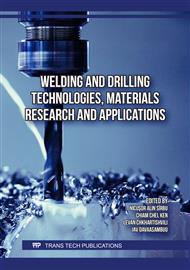[1]
Report Ministry of Energy Mongolia, Ulaanbaatar, 2018.
Google Scholar
[2]
Cabeza LF.Thermal Energy Storage. In: Sayigh A, Comprehensive Renewable Energy.
Google Scholar
[3]
Lavinia Gabriela SOCACIU., Leonardo, Electronic Journal of Practices and Technologies, ISSN 1583-1078.
Google Scholar
[4]
Demirbas M.F., Thermal Energy Storage and Phase Change Materials:(2006)
Google Scholar
[5]
Kays W.M., A.L. London, Compact Heat Exchangers, 2d ed. New York; McGraw-Hill, 1964.
Google Scholar
[6]
Hewitt G. Shires, G. L., Bott T. R. Process Heat Transfer. Boca Raton: CRC Press, (1994)
Google Scholar
[7]
Oleg S. Popel., Vladimir Fortov. Renewable energy in the modern world, ISBN 978-5-383-00959-8.
Google Scholar
[8]
Batmunkh S., Fundamentals of theory and practice of technology for converting solar energy into heat in the natural and climatic conditions of Mongolia (single-subject work), Ulaanbaatar: SHUTIS Publishing House, "Soyombo Printing" Publishing House, 2014. 371 p.
Google Scholar
[9]
Ch. Mangaljalav. Comparative study of seasonal heat accumulators for solar heating systems in Mongolian conditions /, Ch. Mangaljalav, Z. Tserendorj, O. Chimed // Report on the Basic Heating Project of the Ministry of Energy, Ulaanbaatar, 2019.
Google Scholar
[10]
Zihan Liu, Louis Ngai Yuen Wong, Experimental investigation of major rocks in Hong Kong as potential sensible thermal energy storage medium
DOI: 10.1016/j.enggeo.2024.107763
Google Scholar
[11]
K.G. Allen et al.Rock bed storage for solar thermal power plants: rock characteristics, suitability, and availability Sol. Energ. Mat. Sol. C, 2014.
DOI: 10.1016/j.solmat.2014.03.030
Google Scholar
[12]
L. Amiri et al. Numerical investigation of rock-pile based waste heat storage for remote communities in cold climates Appl. Energy, 2019.
DOI: 10.1016/j.apenergy.2019.113475
Google Scholar
[13]
L.M. Barcina et al. Characterization of monumental carbonate stones by thermal analysis (TG, DTG and DSC) Thermochim. Acta, 1997.
DOI: 10.1016/s0040-6031(96)03074-2
Google Scholar
[14]
V. Becattini et al. Experimental investigation of the thermal and mechanical stability of rocks for high-temperature thermal-energy storage Appl. Energy, 2017.
DOI: 10.1016/j.apenergy.2017.06.025
Google Scholar
[15]
B. Bouvry et al. Mediterranean basin basalts as potential materials for thermal energy storage in concentrated solar plants, Sol. Energ. Mat. Sol. C, 2017.
Google Scholar
[16]
Hewitt G. Shires, G. L., coord. Ed., Fluid Mechanics and Heat Transfer, Hemisphere. New York, 1990.
Google Scholar


